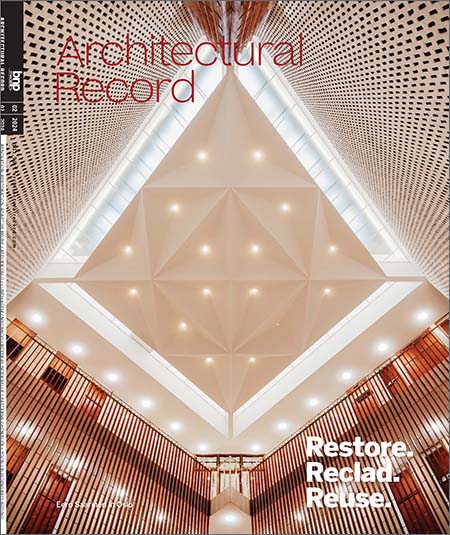When I was doing restoration work in the early 2000s, it seemed like small potatoes. Within the last couple of years, however, architects find they are making more money rehabbing existing buildings than designing new ones. According to a 2022 AIA report, renovation work that year made up the majority of architecture-firm billings for the first time in decades.
The impetus to knock down buildings has waned.

Photo © Einar Aslaksen, click to enlarge.
Our annual issue on renovation, restoration, and adaptive reuse covers several projects that intervene in existing structures. (A series of projects focused specifically on recladding makes up the continuing-education article). Those interventions can be completely transformative—for instance, a supermarket-turned-wellness center immersed in greenery—or, in the case of an Eero Saarinen–designed embassy building in Oslo, featured on the cover, hardly perceptible.
From a run-of-the-mill retail structure to a work by a master of 20th-century architecture, these examples point to the dramatic range of buildings deemed worthy of restoration. No wonder so many express disbelief when certain other buildings are unable to escape the wrecking ball. SOM’s Union Carbide Building—completed in 1960 and demolished in 2021—immediately comes to mind, particularly since the hulking frame of its soon-to-be 1,388-foot-high replacement along Manhattan’s Park Avenue, designed by Foster + Partners, is already taking up a big chunk of the view north from RECORD’s 60th-floor offices at the (still standing) Empire State Building.
Architect Robert A. M. Stern would like to see other buildings avoid Union Carbide’s fate, and for this issue contributes a list of 15 Postmodern examples—which in many parts of the country are approaching “landmark” age. Late last year, news from historian William J.R. Curtis revealed that another one of Le Corbusier’s buildings in India, the Sanskar Kendra Museum of the City of Ahmedabad (1955), as well as Charles Correa’s 1963 Sardar Vallabhbhai Patel Cricket Stadium, were both threatened with demolition. Curtis, who has long kept watch on India’s Modernist legacy, swiftly denounced the reported tear-down plans by the Ahmedabad Municipal Council. “Timeless works [like these] mark a moment in history but then go on to add to the stock of collective memories.”
For a differing perspective, architect Susan Nigra Snyder and historian George E. Thomas argue against too much preservation, criticizing in particular historic districts, which form the cores of major cities, as impeding social, cultural, economic, and political diversity. “In historic districts, a limited past determines the present (and future) by resisting change,” they write in this month’s Forum.
Is one point of view more correct than the other? Market forces, cost, maintenance, structural integrity, and opinions about architectural merit all factor into whether a building can or should be saved. But, in recent years, we’ve all become very familiar with one very strong ally of old buildings—the embodied carbon within them. So, whenever possible: Restore. Reclad. Reuse.






Post a comment to this article
Report Abusive Comment